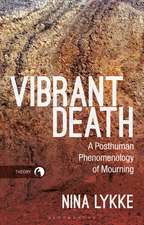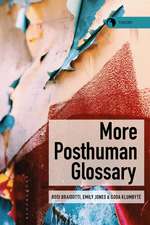Using Digital Humanities in the Classroom: A Practical Introduction for Teachers, Lecturers, and Students
Autor Dr Claire Battershill, Dr Shawna Rossen Limba Engleză Paperback – 20 apr 2022
| Toate formatele și edițiile | Preț | Express |
|---|---|---|
| Paperback (1) | 152.94 lei 3-5 săpt. | +39.73 lei 4-10 zile |
| Bloomsbury Publishing – 20 apr 2022 | 152.94 lei 3-5 săpt. | +39.73 lei 4-10 zile |
| Hardback (1) | 451.51 lei 6-8 săpt. | |
| Bloomsbury Publishing – 20 apr 2022 | 451.51 lei 6-8 săpt. |
Preț: 152.94 lei
Preț vechi: 173.46 lei
-12% Nou
Puncte Express: 229
Preț estimativ în valută:
27.07€ • 31.74$ • 23.73£
27.07€ • 31.74$ • 23.73£
Carte disponibilă
Livrare economică 06-20 ianuarie 26
Livrare express 20-26 decembrie pentru 49.72 lei
Preluare comenzi: 021 569.72.76
Specificații
ISBN-13: 9781350180895
ISBN-10: 1350180890
Pagini: 280
Dimensiuni: 156 x 234 x 24 mm
Greutate: 0.43 kg
Ediția:2
Editura: Bloomsbury Publishing
Colecția Bloomsbury Academic
Locul publicării:London, United Kingdom
ISBN-10: 1350180890
Pagini: 280
Dimensiuni: 156 x 234 x 24 mm
Greutate: 0.43 kg
Ediția:2
Editura: Bloomsbury Publishing
Colecția Bloomsbury Academic
Locul publicării:London, United Kingdom
Caracteristici
Updated online resource: Existing Companion will be updated by repairing broken links, fixing references to obsolete technologies, and adding brand-new materials, including new sample materials and new subsections added to each bibliographic essay, as well as quizzes
Notă biografică
Claire Battershill is an Assistant Professor, cross-appointed in the Faculty of Information and the Department of English, at the University of Toronto, Canada.Shawna Ross is Associate Professor of English at Texas A&M University, USA.
Cuprins
Using Digital Humanities in the Classroom, 2nd editionProposed Table of ContentsPrefacei. Justification for second editionii. New developments in the digital humanitiesIii. Critical digital humanitiesIntroductioni. Who is this book for?ii. What are the digital humanities?iii. Key conceptsiv. How to use this book and Web Companionv. The Web Companionvi. Conclusion1. Finding, Evaluating and Creating Digital Resourcesi. Why use digital texts (and other assets)?ii. Finding and evaluating digital resourcesiii. Creating digital resources for your studentsiv. Creating digital resources with your studentsv. A short guide to citation and copyrightvi. Conclusionvii. Further reading2. Ensuring Accessibilityi. Universal designii. Facilitating lecturesiii. Promoting universal interactivityiv. Providing accessible resourcesv. Privacy, safety, and account managementvi. Learning differencesvii. Adapting policies for individual students and student bodiesviii. Conclusionix. Further reading3. Designing Syllabii. Course websitesii. A note on domains and web hostingiii. Online syllabiiv. Other digital resources for course websitesv. Should you teach an introduction to DH course?vi. An alternative approach: Choosing your amount of DHvii. Anatomy of a syllabus I: Course information and learning objectivesviii. Anatomy of a syllabus II: Course policiesix. Conclusionx. Further reading4. Designing Classroom Activitiesi. Activities as explorationii. Activity design: Balancing integration and flexibilityiii. Ten-minute exercisesiv. Half-hour exercisesv. Whole-class exercisesvi. Weeklong exercisesvii. Writing effective promptsviii. Advanced activitiesix. Conclusionx. Further reading5. Managing Classroom Activitiesi. Working with existing or free resourcesii. Many ways to secure equipmentiii. Troubleshootingiv. In case of total failurev. Conclusionvi. Further reading6. Creating Digital Assignmentsi. General principles for creating digital assignmentsii. Common types of digital assignmentsiii. Writing effective assignment sheetsiv. Advanced assignmentsv. Conclusionvi. Further reading7. Evaluating Student Worki. The importance of explicit assessment criteriaii. Anatomy of a rubriciii. Competencies: A language for indicating successiv. Involving students in evaluation processesv. Thinking beyond the rubricvi. Coping with failure during assessment periodsvii. Conclusionviii. Further reading8. Teaching Graduate Studentsi. The role of technology in twenty-first-century graduate educationii. Graduate students versus undergraduate studentsiii. Incorporating DH into graduate course workiv. External opportunitiesv. Professionalization and the job marketvi. A note on alt-ac careersvii. Conclusionviii. Further reading10. Building Internal and External Support Communitiesi. A note on the variety of support systemsii. Internal Supportiii. Social mediaiv. Grant fundingv. Conclusionvi. Further reading11. DH Beyond the Classroomi. Theories of collaborationii. Impact, outreach, and the public humanitiesiii. Librariesiv. Museums and galleriesv. Local governmentsvi. Non-profits and other NGOsvii. Participatory eventsviii. Conclusionviii. Further reading12. Connecting to Your Researchi. Counting more than onceii. Incorporating digital methods in your researchiii. Producing research on digital pedagogyiv. Broadening the scope of your researchv. Collaborating with studentsvi. Conclusionvii. Further readingConcluding Thoughts: Crafting Your DH Pedagogical PhilosophyIndex
Recenzii
The new edition of Using Digital Humanities in the Classroom extends its already positive and beneficial role, at a time when our thinking about the issues it speaks to have increasing importance. Its new and revised materials continue to build on the first edition's foundation: clear and accessible, learned and pragmatic, broad and deep - and, above all, extremely useful to all those teaching any aspect the digital humanities, new and experienced alike.
This unique book is a goldmine for humanities academics wanting to incorporate digital content into their teaching. In accessible, non-intimidating style, the book and its companion website take you by the hand and guide you through practicalities and logistics. Using it has revolutionised my undergraduate teaching.
This unique book is a goldmine for humanities academics wanting to incorporate digital content into their teaching. In accessible, non-intimidating style, the book and its companion website take you by the hand and guide you through practicalities and logistics. Using it has revolutionised my undergraduate teaching.




























